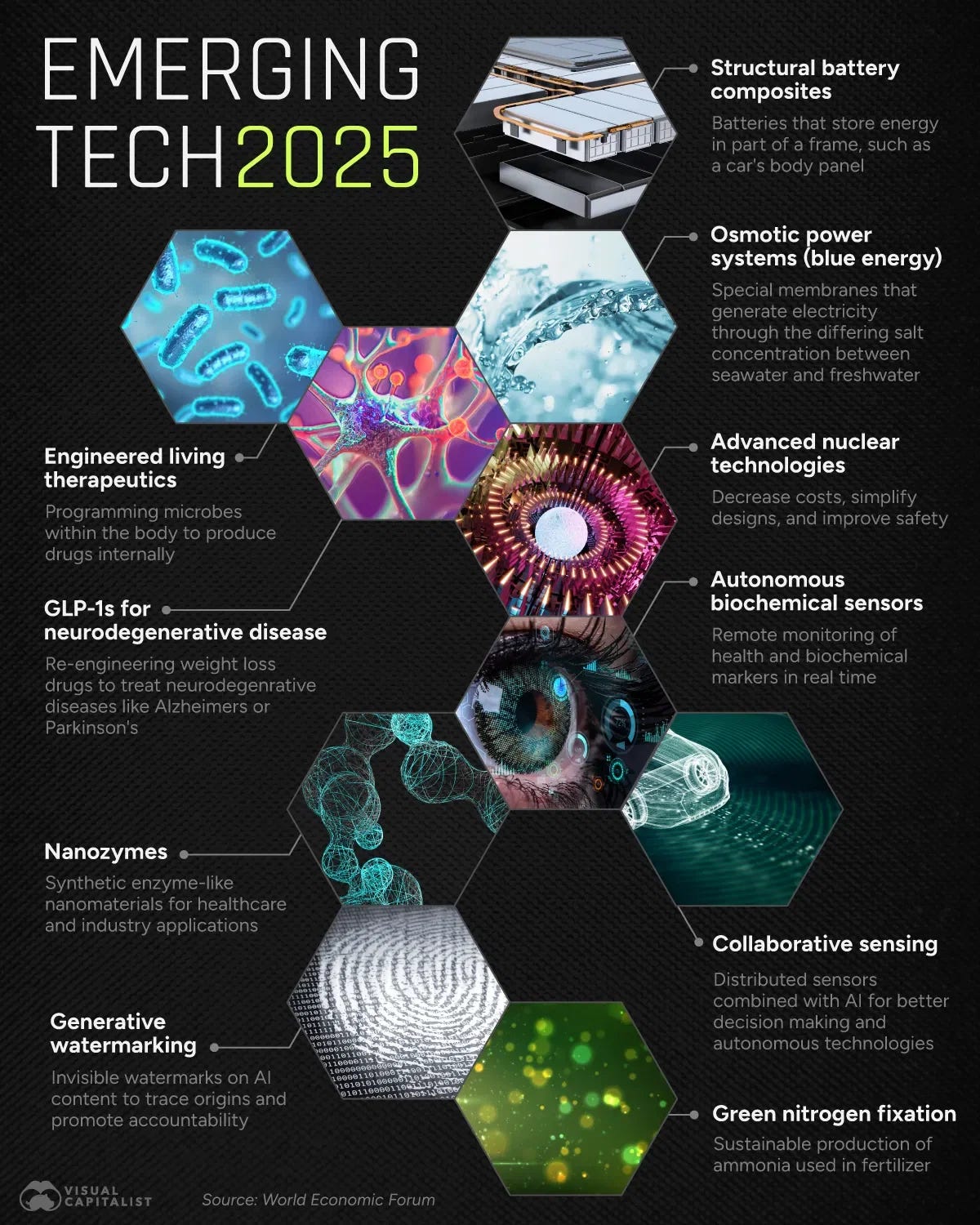Weekly Journal: Viral Band on Spotify Likely AI Generated
[6 min read] Your weekend guide to getting ahead on the digital frontier. Learn about The Velvet Sundown - a clever hoax, or a viral AI experiment?
Welcome to this week’s Weekly Journal 📔, your guide to the latest news & innovation in emerging technology, digital assets, and our exciting path to the Metaverse. This is week 135 of the 520 weeks of newsletters I have committed to, a decade of documenting our physical and digital lives converge. New subscribers are encouraged to check out the history & purpose of this newsletter as well as the archive.
- Ryan
🌐 Digital Assets Market Update
To me, the Metaverse is the convergence of physical & virtual lives. As we work, play and socialise in virtual worlds, we need virtual currencies & assets. These have now reached mainstream finance as a defined asset class:
🔥🗺️Heat map shows the 7 day change in price (red down, green up) and block size is market cap.
🎭 Crypto Fear and Greed Index is an insight into the underlying psychological forces that drives the market’s volatility. Sentiment reveals itself across various channels—from social media activity to Google search trends—and when analysed alongside market data, these signals provide meaningful insight into the prevailing investment climate. The Fear & Greed Index aggregates these inputs, assigning weighted value to each, and distils them into a single, unified score.
🗞️ Metaverse news from this week:
Apple Vision Pro Roadmap Leaks: Lighter Headsets, Lower Prices, and Enterprise Expansion by 2028
A newly leaked roadmap from trusted analyst Ming-Chi Kuo has revealed Apple’s ambitious plans for the Vision Pro product line through 2028—marking a major evolution in the tech giant’s spatial computing strategy.
Despite its current status as a niche, premium device, Apple reportedly plans to refresh the original Vision Pro in late 2025, upgrading it with a powerful new M5 chip, but without addressing common complaints like its weight or battery life. With estimated shipments of only 150,000–200,000 units next year, this update aims to maintain market presence and nurture the XR ecosystem.
In 2027, Apple will shift gears with the debut of Apple Vision Air, a lighter (by 40%) and more affordable mixed-reality headset. It will use glass-to-plastic lens replacement, magnesium alloy frames, and fewer sensors. Powered by the A21 Pro chip (the future flagship iPhone processor), Vision Air will target a wider consumer base with a streamlined form factor and significantly reduced price.
Then comes the Apple Vision Pro 2, slated for mass production in 2028. It will feature an entirely new design, be much lighter, and use a Mac-grade processor, appealing to power users seeking professional-grade spatial computing.
Bloomberg’s Mark Gurman adds another twist: Apple is also exploring a tethered Vision Pro that connects directly to a Mac for enhanced processing. Aimed at enterprise use cases—like operating rooms—this model would reduce wireless latency and support intensive 3D applications via a new macOS Spatial Rendering system.
Meanwhile, Apple is refining its visionOS platform. The upcoming visionOS 2.6 update brings advanced AI features, improved Persona avatars, and deeper integration with Apple Intelligence, aligning its software with the broader push into spatial and AI-driven experiences.
Implications for the Metaverse:
This roadmap reinforces Apple’s methodical approach to spatial computing—not chasing hype, but quietly building a mature, powerful ecosystem. As lighter, cheaper models emerge, Vision may evolve from a curiosity into a mainstream gateway to the metaverse—rooted not in escapism, but in practical, productivity-enhancing augmented reality.
👓 Read of the Week:
In a world accelerating toward exponential technological change, the World Economic Forum's Top 10 Emerging Technologies of 2025 offers a timely and authoritative lens into what’s coming next. From self-healing materials and embedded batteries to generative AI watermarking and living therapeutics, this year’s list doesn’t just track innovation — it captures the tectonic shifts redefining how we live, work, power, and heal. Whether you're a policymaker, investor, or technologist, this report is essential reading to stay ahead of the curve.
🧠 Healthcare & Biotech
Engineered Living Therapeutics
Microbes are programmed to produce drugs inside the body, turning the body into a living pharmacy.GLP-1s for Neurodegenerative Disease
Weight-loss drugs are being re-engineered to treat diseases like Alzheimer’s and Parkinson’s, expanding their therapeutic scope.Nanozymes
Synthetic enzyme-like nanomaterials designed for healthcare and industrial uses, mimicking natural biological processes.Autonomous Biochemical Sensors
Real-time, remote monitoring of health and biochemical markers, enhancing personalised and preventive medicine.
🔋 Energy & Environment
Structural Battery Composites
Energy-storing structural materials, such as car body panels that double as batteries.Osmotic Power Systems (Blue Energy)
Generate power from salt concentration differences between seawater and freshwater via special membranes.Advanced Nuclear Technologies
New designs that simplify, reduce cost, and improve the safety of nuclear power.Green Nitrogen Fixation
Producing ammonia more sustainably, with reduced environmental impact—key for eco-friendly fertilisers.
🤖 AI & Digital Infrastructure
Generative Watermarking
Invisible watermarks on AI-generated content to ensure traceability and accountability in digital media.Collaborative Sensing
Networks of distributed sensors enhanced by AI, improving real-time decision-making and autonomy in machines.
🎥 Watch of the week: Why I Left Quantum Computing Research
In this deeply reflective video, a former Cambridge PhD researcher revisits why they left the field of quantum computing in 2020 — and evaluates whether progress since then changes their view.
With candid clarity, the video walks through:
The real limitations of quantum computers — not in hardware, but in useful algorithms.
Why most tasks (like AI or gaming) are not inherently suited for quantum acceleration.
The hopeful potential of quantum simulations for applications like room-temperature superconductors and next-gen solar cells.
And a refreshingly honest critique: quantum software lags far behind the hype.
Relevance to the Metaverse:
As the metaverse increasingly blends physical, digital, and synthetic realities, the dream of quantum AI agents remains distant. This video reminds us that for now, LLM-powered AI agents are far more capable in real-world tasks. It’s a crucial perspective amid exaggerated claims about quantum’s near-term impact on AI or metaverse computing.
AI Showcase🎨🤖🎵✍🏼: Is “The Velvet Sundown” the First Viral AI Band?
In the Metaverse, AI will be critical for creating intelligent virtual environments and avatars that can understand and respond to users with human-like cognition and natural interactions.
This week, the music world is buzzing over The Velvet Sundown, a mysterious new band with over 850,000 monthly listeners on Spotify — and zero verifiable proof of human involvement. The band has no public interviews, no live performances, and no traceable social media accounts. Even the band photo is suspected to be AI-generated.
What’s fuelling the fire? A Rolling Stone article initially claimed the band’s spokesman admitted the music was made with an AI tool called Suno — only for the same publication to later report that the spokesman was a hoax, part of an elaborate plot to deceive the media. The band has since disavowed the individual, and said they are not affiliated with him or the X (Twitter) account claiming to represent them.
Meanwhile, music detection tools like Deezer’s AI filter have flagged the band’s music as “100% AI-generated” — a claim Spotify has neither confirmed nor denied. Spotify CEO Daniel Ek has previously said AI music is allowed on the platform, so long as it’s not impersonating real artists.
Why it matters:
This incident cuts to the core of a growing crisis in creative industries. As AI music tools grow more powerful, listeners can’t tell what’s human anymore, and artists fear being replaced by algorithmic mimicry. Critics like Ed Newton-Rex of Fairly Trained call it “theft dressed up as competition,” accusing AI developers of using musicians’ work to train models, then flooding the market with derivative content.
Professor Gina Neff of Cambridge warns the issue goes deeper than music: "Our collective grip on reality is becoming shaky." In a world where bands, songs, and even their publicists might be fake, the need for transparency, rights protection, and ethical standards in AI-generated content is more urgent than ever.
Bottom line:
Whether The Velvet Sundown is a clever hoax, a viral AI experiment, or something in between, it’s a powerful symbol of what’s coming. The boundary between human and machine-made creativity is blurring fast — and the battle over authenticity, credit, and copyright has only just begun.
That’s all for this week! If you have any organisations in mind that could benefit from keynotes about emerging technology, be sure to reach out. Public speaking is one of many services I offer.





